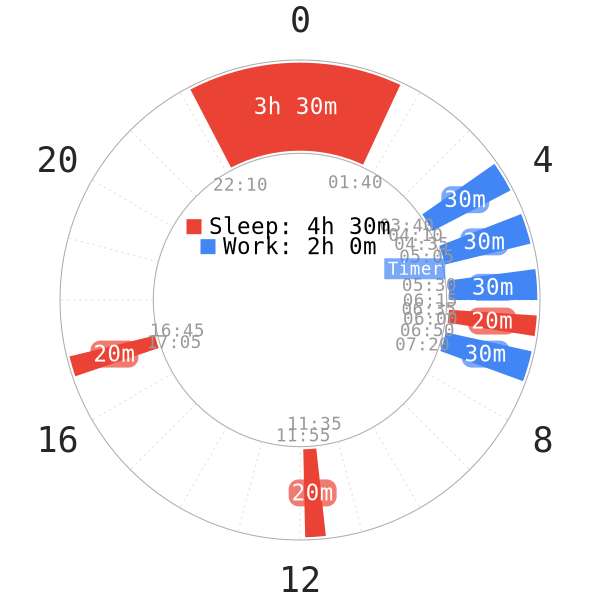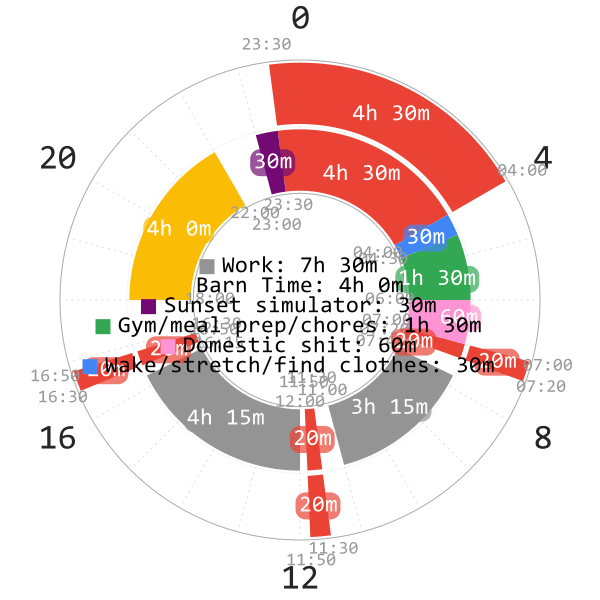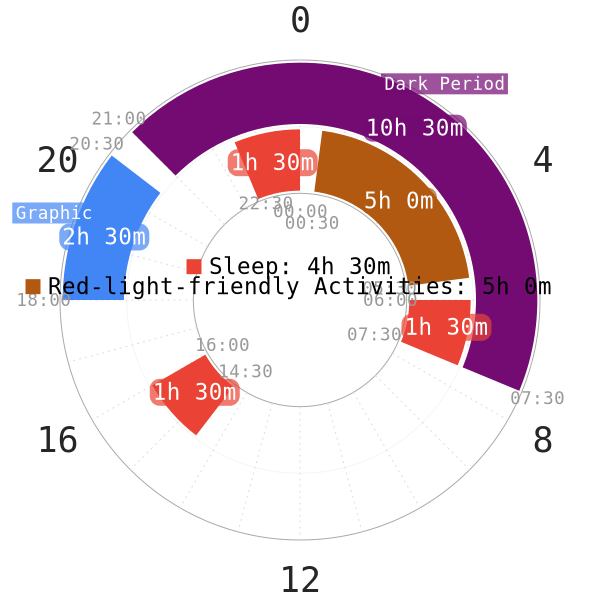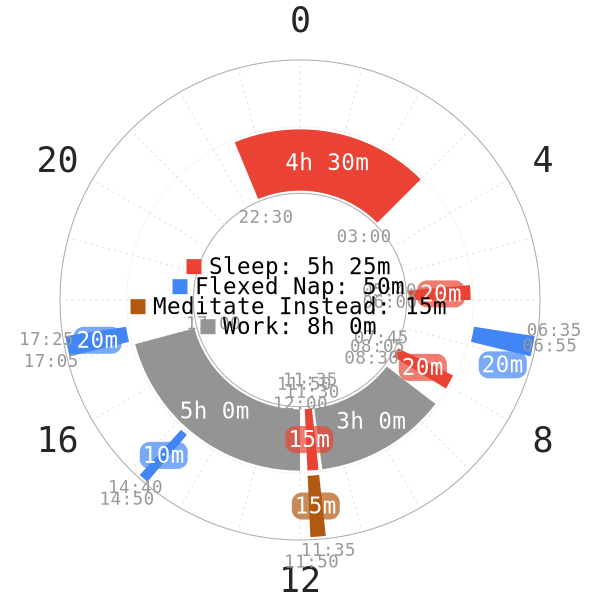Introduction
Parkinson’s law is one of the many available tools to boost personal productivity, performance and time management skills. Previously, we have covered the Eisenhower Matrix and the Pareto Principle; therefore, this time we will focus on applying an alternative method that may suit your personality better than the two aforementioned strategies.
A nap-based lifestyle requires a ton of changes in personal goals and entrenched habits. In addition, it is potentially overwhelming to start out with a completely novel lifestyle. Therefore, we hope that the application of Parkinson’s law can help cope with multiple daily commitments that you may have. For workers who are on a polyphasic schedule, we will showcase how useful it can be.
Time Pressure in Parkinson’s Law
Parkinson’s Law suggests that work will expand or contract based on the amount of time available1. Specifically, more available time will also increase the time it takes to complete a task than less available time. While this sounds obvious, there are actually several studies that confirm its utility1. At first glance, Parkinson’s law may just look like a bad strategy for infamous procrastinators. But, is it true?
The most crucial element of this law is the usage of time pressure. In fact, there have been plenty of records of personal performance when there is the pressure of time. While potentially controversial, time pressure has demonstrated its usefulness. For example, students with much busier daily schedules fare better than those with more, or too much free time2. And this is only one of the many examples that show how time can affect performance.
Because of the unique nature of this time management tool, we think that it is also helpful for polyphasic sleepers.
Parkinson’s Law for Polyphasic Sleepers
Because there are no direct studies on how Parkinson’s law is related to polyphasic sleep, this tool is only a niche for productivity of polyphasic lifestyle. There are two main situations that polyphasic sleepers can make use of this technique.
Adaptation Stage 3
Because this is the most intense adaptation period, you definitely should prepare a lot of plans. This is already obvious across multiple other posts to help you out, but there is one more trick.

- To avoid oversleeping, you can set certain tasks that you have to complete within a short interval of time, like 30 minutes.
- Aside from your should-have big fat to-do list, these can be any activities that you need to complete. For example, complete a game mission within 30 minutes, or 20 minutes, 1 hour, etc. The goal is to stall for some time until your next sleep session.
- It is usually better to aim for a shorter Parkinson’s activity than a longer one. This is because an excessively long activity that requires concentration will tire you out faster than expected. Furthermore, you may not be able to naturally keep up with constant vigilance and attention.
- Remember to take small breaks in between before resuming, but no more than a couple minutes at a time and pace yourself properly.
- Switch up activities to avoid boredom. Use time pressure for as many of them as you like.
- To maximize your productivity output, set timer to complete important tasks when you are most alert. This way you can dedicate a longer period of time for a specific task that requires longer attention.
After Adaptation
After the adaptation phase, you have been used to your sleep schedule. At this point, sleep deprivation symptoms no longer plague you; the greatest news is that you get to work hard and do so many things you could not have achieved before. As such, there are still a couple tips for you to further enhance your productivity with Parkinson’s law.
Hectic Lifestyle

- Keep yourself busy. In our community, the most successful polyphasic sleepers always have a busy lifestyle. Specifically, they have a lot of work to do. Being busy is also a good way to get used to the extra time on any reducing sleep schedules. So far, a lot of polyphasic sleepers have reverted back to monophasic sleep because their polyphasic schedules give them too much free time.
- As mentioned earlier, having less free time also increases efficiency and output to complete tasks under more limited time1.
- You may naturally be able to solve problems much faster than before. These are the problems that would take much longer if you have more idle time.
- Given enough exposure to time pressure, it also boosts your overall time management and organization skills.
Setting Specific Timers for Tasks

- With Parkinson’s law, you will quickly know how much time you only need for some specific tasks. However, these tasks should not be important enough to make you pay. Similar to the Pareto principle, you can delay these tasks to the “last minutes” and still complete them well.
- In the example above, the Triphasic sleeper can dedicate 2.5 hours to complete any graphic-related tasks before his personal dark period. Why it matters is because the dark period with only red light use can affect his work quality. The dark period is also a problem for many polyphasic sleepers.
- The sample duration of 2.5 hours ensures he has enough time to complete his work before the dark period. Specifically, he uses the dark period as a “countdown” time pressure for his work progress.
Using Personal Polyphasic Schedule to Optimize Productivity
After the adaptation phase, you have some more leeway in prioritizing your naps. Depending on schedules, sometimes you can skip or delay it. Therefore, you can actually consider your naps as part of Parkinson’s law.

- For this SEVAMAYL sleeper, he is able to fall asleep in any daytime naps. Therefore, he can opt to delay certain nap(s) if work gets in the way.
- Similarly, you can temporarily rely on meditation if you cannot secure a high-quality nap at the moment. For Parkinson’s law, you can use any of your nap(s) as a timer. Consider napping just a normal task like anything else you have to do each day.
- For example, get a 20-minute nap anytime before 8:30 PM. This way you will not have to stress out over not being able to nap at some exact minute or hours.
- You can proceed with your workflow or whatever tasks matter more than the nap at hand. When you get through the way, cool down and get ready to sleep. The napping experience post-adaptation and some delay of sleep times should suffice for a great incoming nap.
- If you finish your work faster than usual, you may also nap soon after. That nap can act as an alternate “task” that fills up the “extra time” from the work.
- For “-AMAYL” schedules, if you are bored and have absolutely nothing to do, you may nap more often on that day. Napping, or sleeping are also viable ways to deal with the extra time when the schedule does not limit the total amount of sleep.
With all elements in consideration, Parkinson’s law has great versatility for flexible sleep schedules, especially after adaptation. Once again, it shows that polyphasic sleeping can be more “free” than you think.
Downsides & Cautions of Parkinson’s Law
Besides all the promising benefits that Parkinson’s law poses, there are certain downsides to beware of.
- Do not leave your most important tasks until the last minutes! For example, several-month workloads like essays, school applications and preparation for big exams.
- If you have to take your time to do certain tasks that require a lot of attention or do not allow many mistakes, do not rush! Same as the first point, you need a certain amount of available time to dedicate to such challenging duties.
- The whole point of Parkinson’s law is to help boost performance under some pressure, not to use it to procrastinate more! This is because it is often very easy to procrastinate and save top-priority tasks for the last minutes.
- When you are at your lowest point in your adaptation, avoid going all in with your most important tasks. Save them for when your head is clearer.
Conclusion
Conclusively, Parkinson’s law is currently an underused tool in the community; yet, it is totally capable of showing how potent and “natural” it can be for a few people. Working under time pressure has increased output, brainpower and performance in many studies of project management. As such, it has great potential for polyphasic sleepers and the overall busy lifestyle.
With all that said, there are certain precautions polyphasic sleepers should know to use Parkinson’s law properly. In the future, the community would investigate how time pressure can exactly help polyphasic sleepers achieve their lifegoals.
Main author: GeneralNguyen
Page last updated: 5 March 2021
Reference
- Peters, Lawrence H., et al. “The relationship between time pressure and performance: A field test of Parkinson’s Law.” Journal of Occupational Behavior 5.4 (1984): 293-299.
- Ackerman, D. S., & Gross, B. L. (2003). Is Time Pressure All Bad? Measuring the Relationship between Free Time Availability and Student Performance and Perceptions. Marketing Education Review, 13(2), 21–32. doi:10.1080/10528008.2003.11488825.
